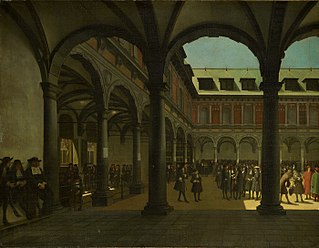
The Padma is a major river in Bangladesh and India. It is the main distributary of the Ganges, flowing generally southeast for 120 kilometres (75 mi) to its confluence with the Meghna River near the Bay of Bengal. The city of Rajshahi is situated on the banks of the river. However, over 256 square miles of land, as large as Chicago, has been lost due to erosion of Padma since 1966.

The University of Rajshahi, also known as Rajshahi University or RU is a public university which is the second largest university in Bangladesh, in Rajshahi, a city in northwestern Bangladesh. It was established in 1953, the second university to be established in what was then East Pakistan. The university is ranked third on the Bangladesh University Ranking 2017.

Kantanagar Temple, commonly known as Kantaji Temple or Kantajew Temple at Kantanagar, is a late-medieval Hindu temple in Dinajpur, Bangladesh. The Kantajew Temple is one of the most magnificent religious edifices belonging to the 18th century. The temple belongs to the popular Hindu Kanta or Krishna and this is most popular with the Radha-Krishna cult in Bengal. This beautiful temple is dedicated to Krishna and his wife Rukmini. Built by Maharaja Pran Nath, its construction started in 1704 CE and ended in the reign of his son Raja Ramnath in 1722 CE. It boasts one of the greatest examples on terracotta architecture in Bangladesh and once had nine spires, but all were destroyed in an earthquake that took place in 1897.

Natore is a district of Rajshahi Division located in northern Bangladesh. It borders the metropolitan city of Rajshahi, and used to be part of Rajshahi district.

Quamrul Hassan was a Bengali artist. Hassan is often referred to in Bangladesh as Potua, a word usually associated with folk artists, due to his down to earth style yet very modern in nature as he always added Cubism other than the folk style to his artworks. In addition to his artistic legacy, two of Hassan's work have come to be part of Bangladesh's political history. The first of this is a monstrous rendition of Yahya Khan, the Pakistani president who ordered genocide in Bangladesh. The second was just before his death, mocking the then dictator of Bangladesh, Hossain Mohammad Ershad. This sketch was titled Desh aaj bisshobeheyar khoppre.
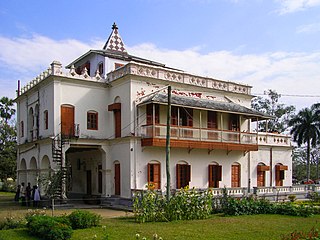
Shilaidaha Kuthibadi is a place in Kumarkhali Upazila of Kushtia District in Bangladesh. The place is famous for Kuthi Bari; a country house made by Dwarkanath Tagore. Rabindranath Tagore lived a part of life here and created some of his memorable poems while living here. The geographic location of this place is 23°55'11.48"N, 89°13'12.11"E.

Rajshahi Cadet College, or RCC, is a military high school, located in Sardah, Rajshahi, Bangladesh. It is situated by the bank of river Padma at Mukhtarpur village of Sardah in Charghat of Rajshahi District of the northern region of Bangladesh.
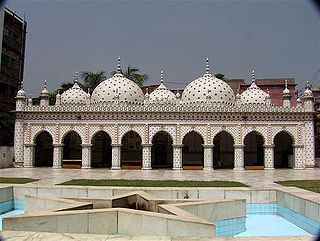
Star Mosque, is a mosque located in Armanitola area, Dhaka, Bangladesh. The mosque has ornate designs and is decorated with motifs of blue stars. It was built in the first half of the 19th century by Mirza Golam Pir.

Bangladesh's tourist attractions include historical monuments, resorts, beaches, picnic spots, forests and tribal people, wildlife of various species. Activities for tourists include angling, water skiing, river cruising, hiking, rowing, yachting, and sea bathing.

The Puthia Temple Complex consists of a cluster of notable old Hindu temples in Puthia Upazila, Rajshahi District, Bangladesh. Located 23 km to the east of Rajshahi city, it has the largest number of historic temples in Bangladesh. The temples were built by Hindu Zamindars Rajas of the Puthia Raj family who were noted philanthropists of Rajshahi. The temples have been built in terracotta in a variety of styles combining the typical Jor-bangla architecture with other influences. The Rajbari or Palace of the Raja of Puthia and the Dol Mancha are part of the complex. The temples are laid out around a lake with a sprawling lawn.

Choto Shona Mosque is located in Chapai Nawabganj district of Bangladesh. The mosque is situated about 3 kilometres (1.9 mi) south of the Kotwali Gate and 0.5 kilometres (0.31 mi) to the south-east of the Mughal Tahakhana complex in the Firozpur Quarter.
Forashganj is a neighborhood in Dhaka, Bangladesh. The name comes from the Bengali word for French which is Forashi and ganj, meaning market-town.

Darasbari Mosque is a historic mosque that was built in 1479 AD and is located in Shibganj Upazila of Chapai Nawabganj District, Bangladesh. It is situated about one kilometer to the south-west Kotwali Gate and about half kilometer to the west of the Choto Sona mosque.
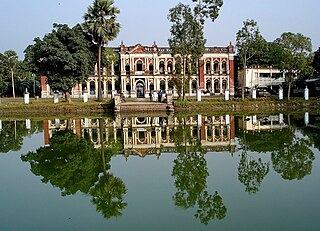
Murapara Rajbari is a well known palace in Rupganj Upazila of Narayanganj District, Bangladesh. The palace is situated in Murapara village, about 25 km southeast of Dhaka on the Narsindghi road. It is connected 5 km stretch of bumpy brick-paved feeder road on the west of main Dhaka- Sylhet trunk road.

Baro Shona Masjid also known as Baroduari, is located in Gour, India. Completed in 1526, it is situated half a kilometer to the south of Ramkeli, 12 km south from Malda in West Bengal. Baro Shona Masjid of Gour, its ruins can be found in Malda, West Bengal, India, very close to the India-Bangladesh border. A gigantic rectangular structure of brick and stone, this mosque is the largest monument in Gour. Though the name means Twelve Doors, this monument actually has eleven.
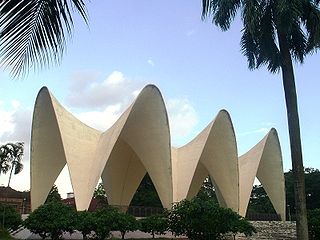
The Mausoleum of three leaders, located at Shahbag, Dhaka in Bangladesh, contains the graves of three pre-liberation politicians from Bengal in the 20th century: A.K. Fazlul Huq (1873–1962), Huseyn Shaheed Suhrawardy (1892–1963) and Khwaja Nazimuddin (1894–1964). All three men served as the Prime Minister of Bengal in British India.

Puthia Rajbari is a palace in Puthia Upazila, in Bangladesh, built in 1895, for Rani Hemanta Kumari, it is an example of Indo-Saracenic Revival architecture. The palace is sited on the Rajshahi Nator highway 30 km from the east of the town and one km south from Rajshahi Nator highway. It is currently used by Lashkarpur Degree College but is in a poor state of repair.
Neel Kuthi was built by the English East India Company, sometime at the beginning of the indigo trade and management. It is a two-storied structure located north of Panam in Sonargaon, Bangladesh across the Mughal Bridge on Dulalpur road. The structure is located at distance from the nearby population.

